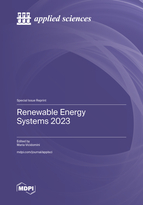Renewable Energy Systems 2023
A special issue of Applied Sciences (ISSN 2076-3417). This special issue belongs to the section "Energy Science and Technology".
Deadline for manuscript submissions: closed (25 November 2023) | Viewed by 35546
Related Special Issue:
Renewable Energy Systems 2020
Special Issue Editor
Interests: solar thermal systems; concentrating photovoltaic/thermal photovoltaic systems; energy saving in buildings; solar heating and cooling; solar desalination; geothermal energy; dynamic simulations of energy systems; renewable polygeneration systems
Special Issues, Collections and Topics in MDPI journals
Special Issue Information
Dear Colleagues,
In the last few years, several countries have experienced a dramatic increase in overall energy demand. Simultaneously, greenhouse gas emissions are increasing, leading to an increase in meteorological catastrophic events in several parts of the world. In this framework, several countries have agreed on the necessity to develop a novel sustainable energy paradigm and to perform all the actions required to limit the increase in the Earth’s average temperature. This goal can be achieved through different strategies: developing novel efficient energy conversion systems, promoting energy efficiency and a more conscious use of energy, and promoting the development of renewable energy sources. As a consequence, during the past few decades, a special effort has been made by several countries to develop novel and innovative energy systems, mainly based on renewable sources. This effort has led to a number of positive effects, such as energy diversification, the reduction in pollutant emissions, and the development of local green economies. On the other hand, the large non-programmable amount of renewable energy delivered to the electric grid poses severe issues in terms of the management of excess energy and the balance between demand and supply. This phenomenon determines an increasing in cost for the management of electric grids, which is typically transferred to the final consumer.
In this context, this Special Issue aims at collecting the most significant and recent studies dealing with the integration of renewable technologies into new or existing water, electricity, heating, and cooling networks. You are encouraged to submit manuscripts analyzing the possible utilization of renewables for multiple purposes (power production, heating, cooling, water management, transports), aiming at increasing the diffusion of such sources into our energy systems. Papers investigating novel electrical and thermal storage systems, as well as the adoption of electrical vehicles, are also welcome.
The topics of primary interest include but are not limited to:
- Energy planning;
- Polygeneration systems based on renewables;
- Advanced thermal storage;
- Advanced electrical storage: compressed air energy storage (CAES), flying wheels, supercapacitors, etc.;
- District heating and cooling systems;
- Water pumping by renewables;
- Thermally driven water desalination;
- Electrically driven water desalination;
- Integration of renewables with transportation, electrical vehicles;
- System dynamic simulation;
- Integration of renewable systems in buildings;
- Control strategies and system management;
- Economical assessment and funding policies;
- Building dynamic simulation.
Dr. Maria Vicidomini
Guest Editor
Manuscript Submission Information
Manuscripts should be submitted online at www.mdpi.com by registering and logging in to this website. Once you are registered, click here to go to the submission form. Manuscripts can be submitted until the deadline. All submissions that pass pre-check are peer-reviewed. Accepted papers will be published continuously in the journal (as soon as accepted) and will be listed together on the special issue website. Research articles, review articles as well as short communications are invited. For planned papers, a title and short abstract (about 100 words) can be sent to the Editorial Office for announcement on this website.
Submitted manuscripts should not have been published previously, nor be under consideration for publication elsewhere (except conference proceedings papers). All manuscripts are thoroughly refereed through a single-blind peer-review process. A guide for authors and other relevant information for submission of manuscripts is available on the Instructions for Authors page. Applied Sciences is an international peer-reviewed open access semimonthly journal published by MDPI.
Please visit the Instructions for Authors page before submitting a manuscript. The Article Processing Charge (APC) for publication in this open access journal is 2400 CHF (Swiss Francs). Submitted papers should be well formatted and use good English. Authors may use MDPI's English editing service prior to publication or during author revisions.
Keywords
- renewable energy systems
- energy saving
- electrical and thermal storage
- simulation
- energy–water nexus






